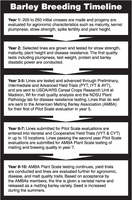Malting Barley Breeding Program Leads to Better Beer
(Click the image below to view a high-resolution image that can be downloaded)
An unfortunate truth that producers know all too well is that not all barley makes good malt and beer.
Although environment plays a large role in the production of high-quality barley, starting with a good variety is essential to producing a quality crop, barley breeders say. Producers depend on existing varieties, but new varieties are needed for various reasons: New diseases develop, environmental conditions change, growing areas shift and new products are developed as consumer habits change.
Yield is important to producers, while quality and homogeneity of supply are important to end users. Regardless of the reasons for developing new varieties, barley breeding is necessary to ensure quality grain, malt and beer, breeders say.
Malting barley is essential to the brewing industry and all stakeholders in the chain from barley to beer cooperate in the breeding and testing processes. In the U.S., most programs dealing with the development of malting barley are public and associated with state universities or the USDA-Agricultural Research Service (ARS). However, Anheuser Busch and Coors do operate private programs. The steps to develop a new malting barley variety can take up to 12 years to complete.
“Cooperation between stakeholder groups occurs in several ways,” says Karen Hertsgaard, North Dakota State University Institute of Barley and Malt Sciences information specialist. “Financial support for breeding efforts comes from industry and grower organizations. Evaluation of field and processing performance is done by both public and private organizations. All provide input on the release of new malting barley varieties.”
The federal government also supports aspects of barley breeding. Examples include the USDA – Cooperative State Research, Education, and Extension Service-funded barley Coordinated Agricultural Project (CAP) and the USDA-ARS-funded U.S. Wheat and Barley Scab Initiative (USWBSI).
The barley CAP seeks to integrate and utilize state-of-the-art genomic tools and approaches in 19 different plant breeding programs throughout the U.S. The focus of CAP research is the identification of molecular markers that will speed up barley breeding efforts dramatically.
The goal of the USWBSI is to develop as quickly as possible effective control measures that minimize the threat of wheat and barley fusarium head blight (scab), including the reduction of mycotoxins, through a national, multidisciplinary and multiinstitutional research system.
Another key group is the American Malting Barley Association (AMBA). It coordinates efforts between the malting and brewing industries and public breeding programs through the Quality Evaluation Program. The purpose of this program is to determine the suitability of new barley selections as malting barley varieties for production in the U.S. The AMBA supports an early generation malting quality evaluation program for barley breeders and basic malting quality research at the USDA-ARS Cereal Crops Research Unit (CCRU) in Madison, Wis.
Early generation testing at the CCRU is followed by pilot scale malting evaluations of more advanced lines by AMBA members. Selections that show promise after two or three years of pilot scale evaluation may be advanced to commercial evaluation. Satisfactory results from plant scale evaluations are required before a variety is recommended for malting and brewing by the AMBA.
“New breeding lines are tested for a number of important barley and malt quality factors,” says Richard Horsley, NDSU barley breeder. “Barley factors include plump kernels, moderate protein levels and a high percentage of kernels that will germinate uniformly and quickly. There are wide ranges of malting quality traits that are tested. The ideal levels of many can vary, depending on the beer style or equipment used to process the beer.”
“Barley malt for brewing needs to have the proper levels of enzymes that break down starch, other carbohydrates and proteins in the barley kernel,” says Scott Heisel, American Malting Barley Association vice president and technical director. “The resulting sugars, peptides and amino acids become soluble in brewing and are collectively referred to as malt extract. The malt extract must have the proper color characteristics and lack factors that could cause hazes or filtration problems in the brewing process.”
In final commercial or plant scale malting and brewing trials, close attention is paid to additional quality factors. The malt must have the proper quality attributes to move through the brewery without any processing problems. It needs to yield a beer with the desired color, foaming characteristics and alcohol content. The final hurdle for a new variety is flavor. Many of these brewing characteristics can’t be adequately judged until commercial scale trials are conducted.
NDSU Agriculture Communication
| Source: | Karen Hertsgaard, (701) 793-1146, karen.hertsgaard@ndsu.edu |
|---|---|
| Source: | Scott Heisel, (414) 272-4640, scott.amba@sbcglobal.net |
| Source: | Richard Horsley, (701) 231-8142, richard.horsley@ndsu.edu |
| Editor: | Rich Mattern, (701) 231-6136, richard.mattern@ndsu.edu |


